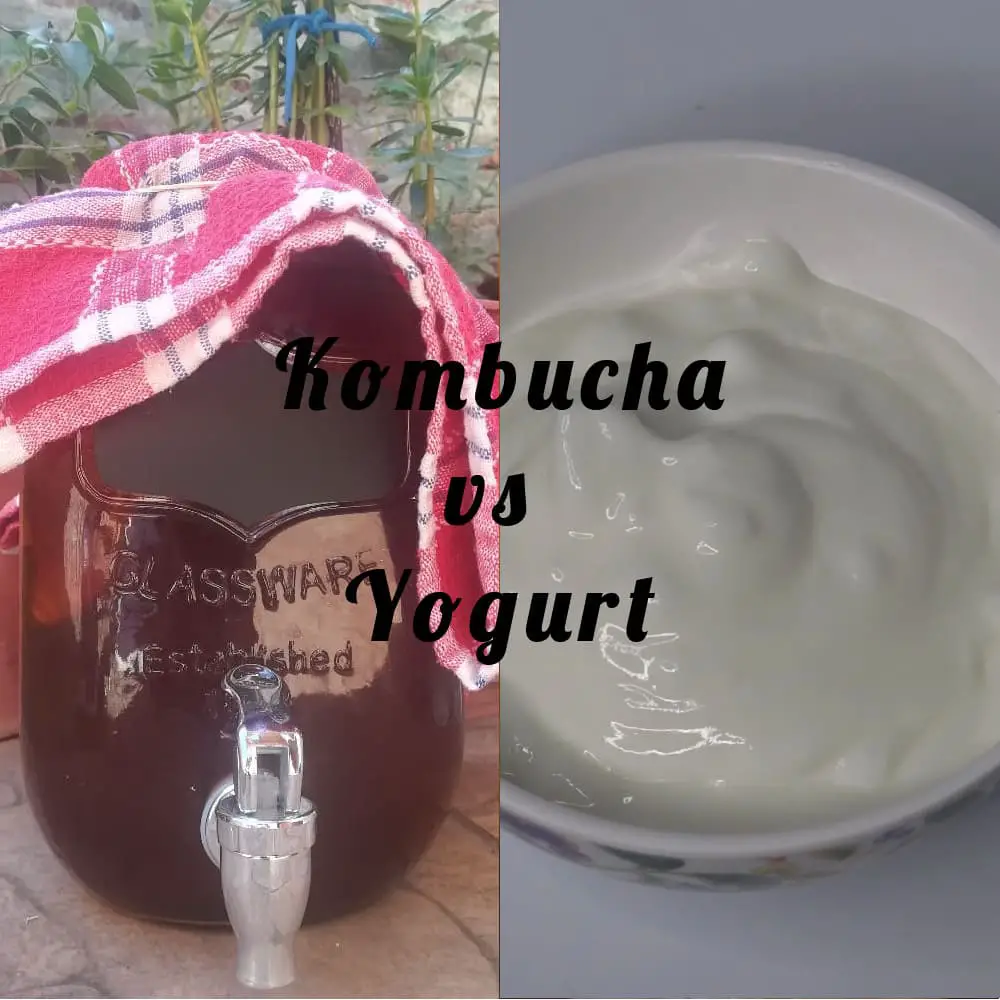Yogurt and kombucha are probiotic foods that come from fermentation through live microorganisms, which when ingested in adequate quantities, have beneficial effects on health, which goes beyond conventional nutritional effects, beneficially affecting one or several functions of the body.
It is important to clarify, although both probiotics have health benefits, they come from different live microorganisms just as the mode of preparation is different.
While kombucha can be prepared from home, the disadvantage for yogurt is usually produced by industry in which synthetic sugars and sweeteners are added making it harmful to the body.
To have a clearer idea about the relationship between conventional yogurt and kombucha, it would be necessary to know what their benefits are, types of microorganisms from which they come, consumers suitable for these drinks and the recommended dose to ingest.
Contents
Why are they confused?
Yogurt and kombucha are two different types of probiotics, but they are confused because both are obtained from fermentation. The above is further aggravated with kefir and yogurt, but we’ll talk about that another time.
One point of confusion is regarding their health benefits, as both products help prevent or deal with certain conditions. For example, yogurt helps improve digestive problems such as diarrhea, irritable bowel syndrome, gastric ulcers. Kombucha on the other hand, contains a high antioxidant power helping to control cholesterol levels. [1]
Yogurt is a type of food that is located in Turkey, although there are also those who place it in the Balkans, Bulgaria or Central Asia and come from the fermentation of lactic acid from milk of animal origin that is formed from streptococci and lactobacilli, while kombucha, is an ancestral drink of Chinese culture and comes from the fermentation of tea in which it is made with yeasts of fungus known as SCOBY and strains of different bacteria, however this term of fungus is not properly said and to clarify this doubt, pay attention to the following descriptions.
Disadvantage of yogurt over kombucha and vice versa.
Yogurt is the product of fermentation of milk with specific bacteria called Lactobacillus delbrueckii bulgaricus and Streptococci thermophilus.
While these bacteria have probiotic characteristics, such as the ability to reduce symptoms of lactose intolerance, and can be found in feces after yogurt consumption, these bacteria have relatively little ability to tolerate the acidic conditions of the stomach, significantly losing viability during gastrointestinal digestion making it one of the disadvantages of this probiotic to take into account.
On the other hand, kombucha tea is not recommended for people who have any intestinal or immune system pathology, pregnant women who have not consumed this food before, lactating women and children under 5 years old since this drink is not pasteurized.
However, kombucha tea has become fashionable, to a large extent, thanks to the many benefits attributed to it and that are directly related to the proper functioning of the body, especially in relation to its character as a probiotic fermented drink.
Are the probiotics in yogurt and kombucha the same?
Yogurt is a milk drink obtained from the fermentation of lactose to produce lactic acid and other chemical structures. Fermentation is carried out by the action of two lactic acid bacteria: Streptococci thermophilus and Lactobacillus delbrueckii Bulgaricus; They are not only responsible for fermentation but are viable and abundant in the final product where they function as probiotics and provide health benefits.
Kombucha is a fermented, traditional non-alcoholic beverage with a history of thousands of years, the same that is prepared by fermenting black tea sweetened with the organic culture of Manchurian fungus, which is a symbiosis of Acetobacter and Gluconobacter bacteria and yeasts such as Saccharomyces, It is often called a mushroom, due to its appearance and texture, but Kombucha is not a fungus, but a colony of bacteria and yeasts that live in symbiosis. Kombucha tea is a sugary black tea drink fermented with Manchurian fungus.
With this description we can conclude that although both are probiotics that come from different living microorganisms. That is, they are not equal.
Which is better, yogurt or kombucha?
Although yogurt is mainly known for its high calcium (Ca) content through milk fermentation, it is also necessary to emphasize that it provides a considerable amount of macro and micronutrients beyond calcium. For example, carbohydrates, lipids, proteins, vitamins, and minerals.
If it is for a sports consumer or who requires gaining muscle mass of course, preferably indicated yogurt, although supplemented with kombucha can have a great effect on longevity.
If it is for the consumer who seeks to include a hypocaloric diet as a goal, his inclination should be for the kombucha drink in view of its properties as antioxidants and diuretics.
Another case would be if the consumer is diagnosed with osteoporosis where he clearly has calcium deficiency in the bones, his inclination would be through yogurt.
It is worth mentioning that it will also depend in the case of yogurt if it is made at home or industrially because this type of food is added sugars harmful to health, for an individual who is diabetic it would be contraindicated.
Everything is according to what the consumer requires for his body for his benefit, therefore, it is very difficult to define a winner. Personally, I consume both almost daily.
Recommended dosage to consume yogurt and kombucha.
Depending on the requirements of the organism the doses may vary, in the case of yogurt the consumption of two yogurts a day provides (depending on the tables of food composition) approximately 350 mg of Ca. Taking into account that a healthy adult requires approximately 800 mg / day of Ca, the consumption of a serving of dairy would cover more than 40% of the nutritional requirements of said micronutrient.
Kombucha tea is a natural drink with no apparent side effects. However, it should be dosed appropriately depending on the tolerance to each of the fermented products and only if necessary; It is advisable to start with a daily intake of «50 to 100 ml» distributed before the main meals up to a maximum of 360ml.
On an empty stomach, you will enhance its detoxifying effect. Before or after meals, it will improve your digestion thanks to its natural probiotics. If you’re especially sensitive to caffeine, we recommend not drinking kombucha around sunset.
It is important to note that kombucha has daily limits that should not be exceeded so as not to generate possible adverse effects. These limits are based on the sugar content, as well as the acidity of the product, so I recommend you read our article on the recommended dosage of kombucha.
What are the contraindications?
In kombucha individuals with compromised immune system, it would be best to consult their doctors. This is too important, since in the literature there have been reported cases of problems that are related to the consumption of kombucha, and although in thousands of years of consumption the cases are counted, they exist.
In childhood below 6 years, in their development they can not tolerate the same degree of supplements and food products as in an adult. Kombucha may be excessively strong because it contains caffeine and less than one degree of alcohol, but it may still generate sensitivity.
In children over 6 years, it should be diluted with water or in a convenient fruit juice such as grapes.
Pregnant and lactation. The reason is the same as in childhood. The nutritional substance of the mother will pass to the newborn child or the infant, being able to act as a powerful laxative since the baby has little developed digestive system.
For some people who suffer from bacterial overgrowth, kombucha consumption is discouraged.
The excessive consumption of this food (yogurt) would cause a high consumption of lipids (fats) therefore it would be contraindicated in obese consumers, in the case of diabetic consumers would be indicated yogurts made at home without added sugar.
Main differences: Kombucha vs Yogurt
Both drinks clearly have to go through a fermentation process for their realization, but the ingredients to be used are different as well as their texture, smell and taste because they are not the same microorganisms or the same fermentation time and even their starting raw material are different.
Yogurt: It is a word of Turkish origin, which arises in the twelfth century; and with this name were known various types of fermented milks in Europe.
From the point of view of its microorganism and fermentation: A gel of viscous appearance, resulting from the microbial acidification of milk. The lactic acid bacteria Lactobacillus delbrueckii bulgaricus and Streptococcus salivarius thermophilus are involved in its fermentation, which must be in a 1:1 ratio for effective symbiotic action.
Fermentation time of approximately 2 weeks, the initial pasteurization treatment of the milk is carried out at a moderate temperature of 80 to 95 degrees then tempered to a temperature of 30 and 45 degrees.
From the point of view of its caloric content: Whole yogurt (with more than 2% fat), semi-skimmed yogurt (between 0.5% and 2% fat) and skimmed yogurt (less than 0.5% fat). A typical Greek yogurt has a high level of protein (> 8%) and high fat content (8-9%),
From the point of view of its texture and color: Static or firm yogurt (semi-solid in nature), whipped yogurt (more liquid in nature), liquid yogurt (with very low viscosity). Homogeneous color and white.
From the point of view of its aroma: Natural yogurt (with neutral smell), flavored yogurt (with synthetic aromas) and fruit yogurt (with fruity aroma).
Kombucha: It is popularly known as the «black tea mushroom» and its consumption was first discovered in Manchuria-China, 220 years BC, it is a 100% natural drink.
From the point of view of its microorganism and fermentation: It is a living colony of fungi and bacteria in symbiotic growth, the main acetic acid bacteria found in Kombucha are: Acetobacter xylinum, Gluconobacter bluconicum. The yeasts identified in fermented tea are: Schizosaccharomyces pombe, Saccharomycodes ludwigii, Saccharomyces cerevisiae, Zygosaccharomyces bailii, Kloecera apiculata, Brettanomyces bruxellensis, Brettanomyces lambicus, Brettanomyces custersii, Candida stellata. [2][3]
Fermentation time to obtain a good kombucha with acceptable pH levels requires 7 – 15 days at an average ambient temperature of 23°C.
From the point of view of its caloric content: It is a low-calorie drink because it has a percentage of fat 0%, carbohydrates 100%, proteins 0%. With a high source of different vitamins such as:
- Vitamins: B1, B2, B3, B6, B12, folic acid, C, D, E and K. Enzymes, essential organic acids and minerals: iron, potassium, zinc, manganese, copper, calcium, magnesium.
From the point of view of its texture and color: Kombucha has a totally liquid texture, which depending on its preparation, may have small traces of yeast in its liquid. Based on its production with black tea, it begins with very reddish gorse or dark, which then becomes more orange.
From the point of view of its aroma and flavor: Depending on its fermentation days it can change its flavor. If it is 7 to 15 days, it will have a slightly acidic taste characteristic of the drink; while if we do it in 7 days you get a drink similar to cider when tasted with a somewhat sweet taste.
We will clarify some of the main differences in a comparative style chart to make it clearer and more concise for readers.
| Characteristics | yogurt | kombucha |
| Origin | Turkey | China |
| Microorganisms | Bacteria (streptococci and lactobacilli) | Bacteria and yeasts |
| Nutrition | High in calories (proteins and lipids) | Low calorie (high in vitamins) |
| Taste | Very acidic | Acid |
| Texture | Thickening, creamy or liquid | Liquid |
| Smell | Slightly acidic | Slightly vinegary |
| Colour | White | Brown |
| Fermentation time | 14 days | 7 to 15 days |
| Fermentation temperature | 80 to 95°C initial then 30 to 45°C | 23°C |

